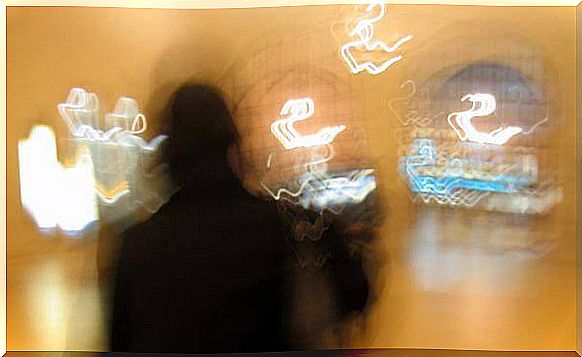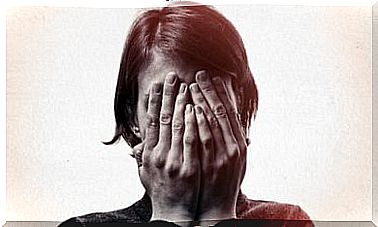Depersonalization Disorder: Who Am I Really?

“My thoughts don’t seem mine” “Who am I” “I don’t recognize myself in the mirror.” These types of experiences occur frequently in people with depersonalization disorder. Likewise, it is very recurrent among those who go through a period of high anxiety and stress.
The search for our own identity and our place in the world is a constant. We have all ever wondered who we are, where we come from and where we are going. It is normal. However, in depersonalization disorder it occurs with much more frequency and intensity.

What is depersonalization?
Depersonalization disorder is characterized by persistent or recurring episodes of depersonalization, derealization, or both.
- Studies like the one carried out at the London Institute of Psychiatry reveal something interesting. What the person experiences is a very intense emotional reaction. In fact, magnetic resonance imaging shows great activity in the cerebral insula.
- You suffer a feeling of unreality, strangeness or a general distancing from yourself.
- The person with depersonalization may feel separate from their entire being (eg, “I am nobody”, “I have nothing of myself”).
- This can even cause you to not accept your own emotions, thoughts, feelings …
Patients often describe it as a robotic sensation, like an automaton, lacking control of one’s own speech or movements.

Perception failures, a feature of derealization
The environment can be seen as artificial, colorless or lifeless. Derealization is usually accompanied by subjective visual distortions. These can be blurred vision, increased visual acuity, expanded or reduced visual field, two-dimensionality …
- There may also be alterations in the distance or size of objects. Macropsia is one of these effects, and it consists of seeing objects larger than they really are. Micropsy, for its part, is the opposite. We see objects smaller than they really are.
- Auditory distortions appear, silencing or accentuating voices or sounds.
Exclusionary criteria
It must be made clear that, for this disorder to be diagnosed, the aforementioned alterations cannot be the result of the intake of drugs, medications or a disease (such as epilepsy).
Nor should these conditions be a criterion for schizophrenia, panic disorder, major depression, acute stress disorder, or post-traumatic stress disorder.
Subjective characteristics of depersonalization disorder
People with depersonalization disorder may have a hard time describing their symptoms. Also, they have the feeling that they are going crazy. Another common experience is the fear of irreversible brain damage.
- Another common symptom is subjective alteration of the sense of time (eg, too fast, too slow).
- Likewise, there is also a subjective difficulty to vividly remember past memories (and feel part of them).
- On the other hand, they also tend to feel something similar to a saturation of the head, tingling or the sensation of fainting are not uncommon.
Furthermore, it is not uncommon to find different degrees of anxiety or depression in people suffering from depersonalization episodes. Something curious that has been observed is that these people tend to react physiologically more intensely to emotional stimuli.
These physiological changes occur due to the activation of the hypothalamic-pituitary-adrenal axis, the lower parietal lobe and the circuits of the limbic prefrontal cortex.

How is the diagnosis of depersonalization disorder made?
According to the Diagnostic and Statistical Manual of Mental Disorders (DSM-V), the person diagnosed with depersonalization / derealization disorder has to meet the following diagnostic criteria:
A. Presence of persistent or recurring experiences of depersonalization, derealization
- Depersonalization: experiences of unreality, distancing, of being an external observer regarding one’s thoughts, feelings, sensations, body or actions.
- Derealization: experiences of unreality or distance from the environment. For example, people or objects are experienced as unreal, dreamlike, hazy, lifeless, or visually distorted).
B. During depersonalization or derealization experiences, reality tests remain intact.
C. Symptoms involve clinically significant distress or impairment in social, occupational, or other important areas of functioning.
D. The alteration cannot be attributed to the physiological effects of a substance. For example, drug, medication, or other medical condition (eg, epilepsy).
E. The disturbance is not better explained by another mental disorder, such as schizophrenia, panic disorder, major depressive disorder, acute stress disorder, post-traumatic stress disorder, or other dissociative disorder.
How does depersonalization disorder develop and what is the course?
On average, depersonalization / derealization disorder begins to manifest at age 16, although the disorder can begin in early to mid-childhood. In fact, most recall having symptoms already at this stage.
- More than 20% of cases appear after 20 years and only 5% after 25.
- The appearance in the fourth decade of life or later is very unusual.
- The onset can be extremely sudden or gradual. The duration of depersonalization / derealization episodes can vary widely, from brief (hours or days) to long (weeks, months, or years).
A chronic clinical condition
Given the rarity of the disorder onset after age 40, there may be underlying medical conditions in these cases. These conditions can be brain injury, seizure disorders, or sleep apnea.
- The course of the disease is often chronic. While in some people the intensity of symptoms can increase and decrease considerably, others report a constant level of intensity that, in extreme cases, can be recurrent for years or decades.
- On the other hand, the increase in the intensity of symptoms can be caused by stress, by worsening mood or anxiety symptoms, by new stimulating circumstances and by physical factors, such as lighting or lack of sleep.
Also, something important should be noted: not all people who have some of these symptoms will develop the disorder.

Treatment
The therapeutic strategy for depersonalization disorder usually goes through two basic strategies: pharmacological (with psychotropic drugs such as naloxone) and psychotherapeutic.
Thus, cognitive-behavioral therapies have a good success rate in these cases. The objective will be to strengthen the patient’s connection with himself.









